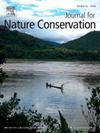Ghost fishing by self-baited lost, abandoned or discarded pots in snow crab (Chionoecetes opilio) fishery
IF 2.2
3区 环境科学与生态学
Q2 BIODIVERSITY CONSERVATION
引用次数: 0
Abstract
Unintended continuous capture or so-called “ghost fishing”, by abandoned, lost, or otherwise discarded fishing gear produces negative environmental impact on marine life and nature conservation. The risk of ghost fishing in pots could be high due to potential self-baiting resulting from mortality of ghost fished catch. Self-baiting may increase ghost fishing by further attracting marine organisms, including cannibalistic conspecifics. However, self-baiting effect in pot fisheries is seldom investigated. Pot fisheries targeting snow crab (Chionoecetes opilio) in the Arctic have high risk of gear loss due to harsh weather conditions. This study quantifies ghost fishing efficiency by simulated self-baited snow crab pots containing dead snow crab relative to catch efficiency of actively fished baited pots. On average, self-baited pots captured 0.4% of target-sized snow crab compared to actively fished pots. These results showed that the impact on marine environment caused by ghost fishing in pots is not always increasing due to self-baiting and can vary throughout the time pots are exposed to ghost fishing.
在雪蟹(Chionoecetes opilio)渔业中利用自带诱饵的遗失、遗弃或丢弃渔盆进行幽灵捕捞
被遗弃、丢失或以其他方式丢弃的渔具的意外连续捕获或所谓的 "幽灵捕鱼 "会对海洋生物和自然保护产生负面的环境影响。由于幽灵捕捞渔获物的死亡可能会导致自投鱼饵,因此罐头幽灵捕捞的风险可能很高。自投饵可能会进一步吸引海洋生物,包括食人的同类,从而增加幽灵捕捞。然而,很少对盆栽渔业中的自投饵效应进行调查。北极地区以雪蟹(Chionoecetes opilio)为目标的盆式渔业由于恶劣的天气条件,渔具丢失的风险很高。本研究通过模拟装有死亡雪蟹的自投饵雪蟹罐,量化了幽灵捕捞效率与主动捕捞投饵罐的捕获效率。与主动捕捞的渔盆相比,自放鱼饵的渔盆平均捕获了 0.4% 的目标规格雪蟹。这些结果表明,锅内幽灵捕捞对海洋环境的影响并不总是因自投饵而增加,在锅暴露于幽灵捕捞的整个过程中都会发生变化。
本文章由计算机程序翻译,如有差异,请以英文原文为准。
求助全文
约1分钟内获得全文
求助全文
来源期刊

Journal for Nature Conservation
环境科学-生态学
CiteScore
3.70
自引率
5.00%
发文量
151
审稿时长
7.9 weeks
期刊介绍:
The Journal for Nature Conservation addresses concepts, methods and techniques for nature conservation. This international and interdisciplinary journal encourages collaboration between scientists and practitioners, including the integration of biodiversity issues with social and economic concepts. Therefore, conceptual, technical and methodological papers, as well as reviews, research papers, and short communications are welcomed from a wide range of disciplines, including theoretical ecology, landscape ecology, restoration ecology, ecological modelling, and others, provided that there is a clear connection and immediate relevance to nature conservation.
Manuscripts without any immediate conservation context, such as inventories, distribution modelling, genetic studies, animal behaviour, plant physiology, will not be considered for this journal; though such data may be useful for conservationists and managers in the future, this is outside of the current scope of the journal.
 求助内容:
求助内容: 应助结果提醒方式:
应助结果提醒方式:


